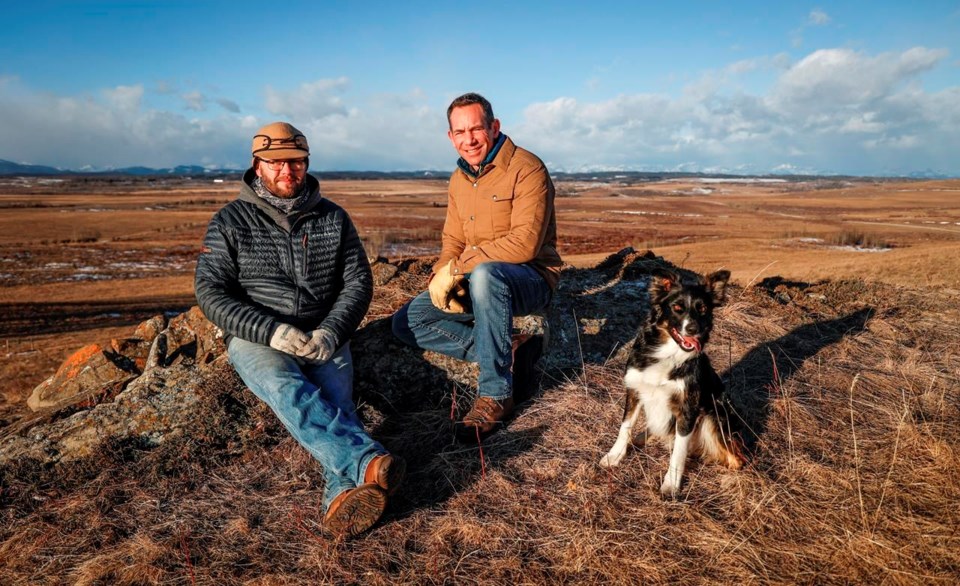ROCKY VIEW COUNTY, ALBERTA, CANADA — Justin Thompson and Matt Kumlin walk up a hill toward a ridge in the Alberta foothills as a border collie and "cow-dog-in-training" named Newt tags along.
At the top of the ridge, the snow-capped Rocky Mountains are visible to the west. Calgary's downtown is about 40 kilometres to the east.
More than six square kilometres of the property around them has been protected by the Kumlin family with a conservation easement, which restricts land uses that could damage its ecological health.
"The easement was mostly an assurance that the land will be rangeland forever," said Kumlin, a 34-year-old veterinarian. He and his wife, Angela, took over management of the fifth-generation cow-calf ranch from his father, Alvin, in 2018.
The easement works to prevent future development, particularly housing, that would "deter from the nature of the ranch."
It is one of three new projects by the Southern Alberta Land Trust Society, a rancher-led conservation organization, that will protect about 27-square kilometres of land in the area. That's similar in size to two-and-a-half Nose Hill Parks in Calgary or 17 High Parks in Toronto.
Thompson, executive director of the land trust, said the easements around Jumpingpound Creek, which flows into the Bow River that runs through Calgary, could also help to protect the city's drinking water.
"These easements will keep this landscape in forest and grasslands, which means they will continue to help store and filter water for everyone downstream," he said.
"Our watersheds upstream of the cities have continued to have more and more development — more houses, more roads, more industrial development — and, with those developments, the ability of the landscape to store and filter water has diminished."
Ranching, he said, is one of the most compatible uses to protect watersheds and wildlife habitat because it keeps the land in a more natural state.
The land trust has conserved more than 162 square kilometres in Alberta's foothills and grasslands in the past 25 years. Those protected lands, it says, include areas along beloved fishing rivers, open spaces along the scenic Cowboy Trail on the eastern slopes of the Rockies and land in the headwaters of both the Bow and Oldman rivers.
In addition to protecting water flowing into Calgary and Lethbridge, Alta., Thompson said the land can also support recreation and tourism as well as provide flood and drought mitigation for those cities.
The projects received money from provincial and federal governments, as well as $1 million from the Calgary Foundation for the most recent easements.
"This project is an unprecedented opportunity to secure three conservation easements … of ranch lands vital to the protection of Calgary's source watershed," the foundation said on its website.
Thompson said he's also hoping to work more closely with officials from the City of Calgary, which adopted a source water protection policy in 2020.
"They are starting to look outside the boundaries of the city, realizing that their water comes from outside the boundary of the city and trying to figure out what partnerships, what investments they might be able to make upstream to make sure Calgary's drinking water is clean into the future," he said.
The city's policy states it is to work with partners upstream to support land uses and water management practices to maintain water quality, as well as reduce the effects of floods and droughts.
"Much of the Bow and Elbow River watersheds that supply Calgary's drinking water remain relatively pristine," it says. "Protecting our drinking water at its source is critical to ensure we maintain clean, safe, reliable drinking water to our customers and other downstream communities that also depend on the rivers."
The city's source water protection plan, which supports the policy, says Rocky View County's jurisdiction extends over 12 per cent of the source watershed, with much of the land close to the city limits in private ownership.
For Kumlin, one of those private landowners, putting an easement on the part of the ranch along Jumpingpound Creek was a family decision "to conserve the land in its natural state and prevent further development in the future for future generations."
Not only does it allow his family to ranch indefinitely, he said, but it also provides wildlife habitat and clean water for those living downstream.
This report by The Canadian Press was first published Feb. 14, 2023.
Colette Derworiz, The Canadian Press




